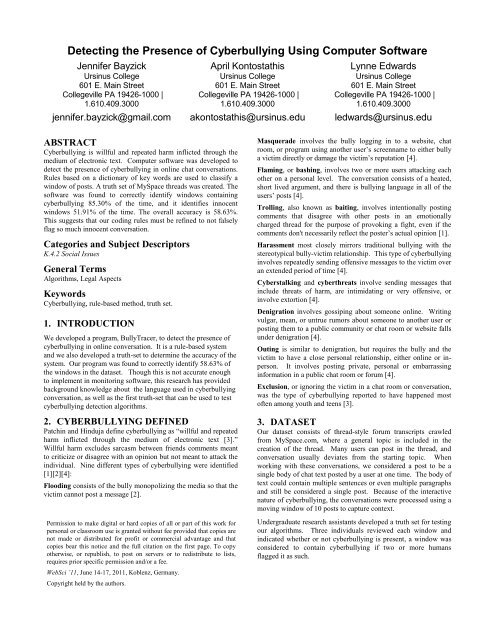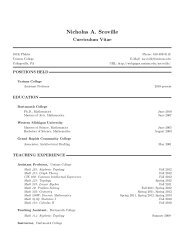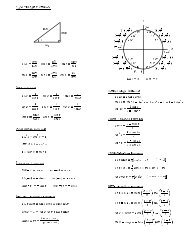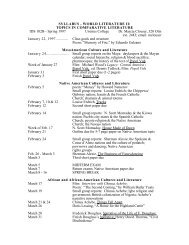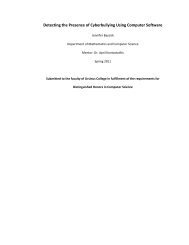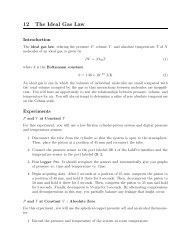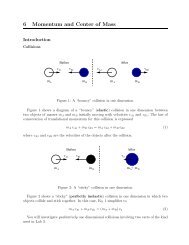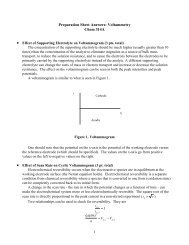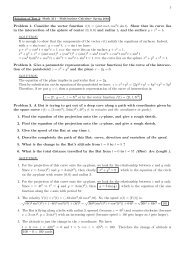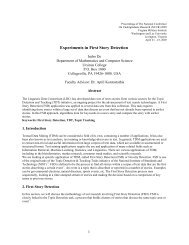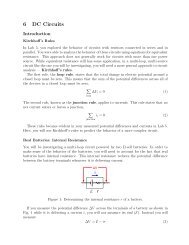Detecting the Presence of Cyberbullying Using Computer Software.
Detecting the Presence of Cyberbullying Using Computer Software.
Detecting the Presence of Cyberbullying Using Computer Software.
You also want an ePaper? Increase the reach of your titles
YUMPU automatically turns print PDFs into web optimized ePapers that Google loves.
<strong>Detecting</strong> <strong>the</strong> <strong>Presence</strong> <strong>of</strong> <strong>Cyberbullying</strong> <strong>Using</strong> <strong>Computer</strong> S<strong>of</strong>tware<br />
Jennifer Bayzick<br />
Ursinus College<br />
601 E. Main Street<br />
Collegeville PA 19426-1000 |<br />
1.610.409.3000<br />
jennifer.bayzick@gmail.com<br />
April Kontostathis<br />
Ursinus College<br />
601 E. Main Street<br />
Collegeville PA 19426-1000 |<br />
1.610.409.3000<br />
akontostathis@ursinus.edu<br />
Lynne Edwards<br />
Ursinus College<br />
601 E. Main Street<br />
Collegeville PA 19426-1000 |<br />
1.610.409.3000<br />
ledwards@ursinus.edu<br />
ABSTRACT<br />
<strong>Cyberbullying</strong> is willful and repeated harm inflicted through <strong>the</strong><br />
medium <strong>of</strong> electronic text. <strong>Computer</strong> s<strong>of</strong>tware was developed to<br />
detect <strong>the</strong> presence <strong>of</strong> cyberbullying in online chat conversations.<br />
Rules based on a dictionary <strong>of</strong> key words are used to classify a<br />
window <strong>of</strong> posts. A truth set <strong>of</strong> MySpace threads was created. The<br />
s<strong>of</strong>tware was found to correctly identify windows containing<br />
cyberbullying 85.30% <strong>of</strong> <strong>the</strong> time, and it identifies innocent<br />
windows 51.91% <strong>of</strong> <strong>the</strong> time. The overall accuracy is 58.63%.<br />
This suggests that our coding rules must be refined to not falsely<br />
flag so much innocent conversation.<br />
Categories and Subject Descriptors<br />
K.4.2 Social Issues<br />
General Terms<br />
Algorithms, Legal Aspects<br />
Keywords<br />
<strong>Cyberbullying</strong>, rule-based method, truth set.<br />
1. INTRODUCTION<br />
We developed a program, BullyTracer, to detect <strong>the</strong> presence <strong>of</strong><br />
cyberbullying in online conversation. It is a rule-based system<br />
and we also developed a truth-set to determine <strong>the</strong> accuracy <strong>of</strong> <strong>the</strong><br />
system. Our program was found to correctly identify 58.63% <strong>of</strong><br />
<strong>the</strong> windows in <strong>the</strong> dataset. Though this is not accurate enough<br />
to implement in monitoring s<strong>of</strong>tware, this research has provided<br />
background knowledge about <strong>the</strong> language used in cyberbullying<br />
conversation, as well as <strong>the</strong> first truth-set that can be used to test<br />
cyberbullying detection algorithms.<br />
2. CYBERBULLYING DEFINED<br />
Patchin and Hinduja define cyberbullying as “willful and repeated<br />
harm inflicted through <strong>the</strong> medium <strong>of</strong> electronic text [3].”<br />
Willful harm excludes sarcasm between friends comments meant<br />
to criticize or disagree with an opinion but not meant to attack <strong>the</strong><br />
individual. Nine different types <strong>of</strong> cyberbullying were identified<br />
[1][2][4]:<br />
Flooding consists <strong>of</strong> <strong>the</strong> bully monopolizing <strong>the</strong> media so that <strong>the</strong><br />
victim cannot post a message [2].<br />
Permission to make digital or hard copies <strong>of</strong> all or part <strong>of</strong> this work for<br />
personal or classroom use is granted without fee provided that copies are<br />
not made or distributed for pr<strong>of</strong>it or commercial advantage and that<br />
copies bear this notice and <strong>the</strong> full citation on <strong>the</strong> first page. To copy<br />
o<strong>the</strong>rwise, or republish, to post on servers or to redistribute to lists,<br />
requires prior specific permission and/or a fee.<br />
WebSci ’11, June 14-17, 2011, Koblenz, Germany.<br />
Copyright held by <strong>the</strong> authors.<br />
Masquerade involves <strong>the</strong> bully logging in to a website, chat<br />
room, or program using ano<strong>the</strong>r user’s screenname to ei<strong>the</strong>r bully<br />
a victim directly or damage <strong>the</strong> victim’s reputation [4].<br />
Flaming, or bashing, involves two or more users attacking each<br />
o<strong>the</strong>r on a personal level. The conversation consists <strong>of</strong> a heated,<br />
short lived argument, and <strong>the</strong>re is bullying language in all <strong>of</strong> <strong>the</strong><br />
users’ posts [4].<br />
Trolling, also known as baiting, involves intentionally posting<br />
comments that disagree with o<strong>the</strong>r posts in an emotionally<br />
charged thread for <strong>the</strong> purpose <strong>of</strong> provoking a fight, even if <strong>the</strong><br />
comments don't necessarily reflect <strong>the</strong> poster’s actual opinion [1].<br />
Harassment most closely mirrors traditional bullying with <strong>the</strong><br />
stereotypical bully-victim relationship. This type <strong>of</strong> cyberbullying<br />
involves repeatedly sending <strong>of</strong>fensive messages to <strong>the</strong> victim over<br />
an extended period <strong>of</strong> time [4].<br />
Cyberstalking and cyberthreats involve sending messages that<br />
include threats <strong>of</strong> harm, are intimidating or very <strong>of</strong>fensive, or<br />
involve extortion [4].<br />
Denigration involves gossiping about someone online. Writing<br />
vulgar, mean, or untrue rumors about someone to ano<strong>the</strong>r user or<br />
posting <strong>the</strong>m to a public community or chat room or website falls<br />
under denigration [4].<br />
Outing is similar to denigration, but requires <strong>the</strong> bully and <strong>the</strong><br />
victim to have a close personal relationship, ei<strong>the</strong>r online or inperson.<br />
It involves posting private, personal or embarrassing<br />
information in a public chat room or forum [4].<br />
Exclusion, or ignoring <strong>the</strong> victim in a chat room or conversation,<br />
was <strong>the</strong> type <strong>of</strong> cyberbullying reported to have happened most<br />
<strong>of</strong>ten among youth and teens [3].<br />
3. DATASET<br />
Our dataset consists <strong>of</strong> thread-style forum transcripts crawled<br />
from MySpace.com, where a general topic is included in <strong>the</strong><br />
creation <strong>of</strong> <strong>the</strong> thread. Many users can post in <strong>the</strong> thread, and<br />
conversation usually deviates from <strong>the</strong> starting topic. When<br />
working with <strong>the</strong>se conversations, we considered a post to be a<br />
single body <strong>of</strong> chat text posted by a user at one time. The body <strong>of</strong><br />
text could contain multiple sentences or even multiple paragraphs<br />
and still be considered a single post. Because <strong>of</strong> <strong>the</strong> interactive<br />
nature <strong>of</strong> cyberbullying, <strong>the</strong> conversations were processed using a<br />
moving window <strong>of</strong> 10 posts to capture context.<br />
Undergraduate research assistants developed a truth set for testing<br />
our algorithms. Three individuals reviewed each window and<br />
indicated whe<strong>the</strong>r or not cyberbullying is present, a window was<br />
considered to contain cyberbullying if two or more humans<br />
flagged it as such.
4. BULLYTRACER<br />
BullyTracer is a program designed to detect <strong>the</strong> presence <strong>of</strong><br />
different types <strong>of</strong> cyberbullying in a chat room conversation. We<br />
describe its first version in this section. This paper lays <strong>the</strong><br />
groundwork for fur<strong>the</strong>r examination <strong>of</strong> <strong>the</strong> linguistic components<br />
<strong>of</strong> a cyberbullying conversation, <strong>the</strong> distinction between various<br />
types <strong>of</strong> cyberbullying, and <strong>the</strong> algorithms used to detect <strong>the</strong><br />
presence <strong>of</strong> cyberbullying language. BullyTracer analyzes all files<br />
in given directory using a rule-based Algorithm.<br />
BullyTracer uses a dictionary <strong>of</strong> code words that fall into <strong>the</strong><br />
categories: insult word (retarded, dumb), swear word (bitch,<br />
fucker), and second person pronouns (you, your). BullyTracer<br />
marks each post in a window with <strong>the</strong> category <strong>of</strong> any words<br />
found in <strong>the</strong> dictionary. These categories were chosen because<br />
<strong>the</strong>y seemed to have <strong>the</strong> highest correlation to <strong>the</strong> presence <strong>of</strong><br />
cyberbullying in a chat post. Insults and swear words indicate<br />
hostility and mean-spiritedness from <strong>the</strong> user who posted <strong>the</strong>m.<br />
Second person pronouns help to distinguish <strong>the</strong> object <strong>of</strong> <strong>the</strong><br />
nasty words.<br />
Ano<strong>the</strong>r indication <strong>of</strong> hostile language is <strong>the</strong> use <strong>of</strong> many capital<br />
letters. General use <strong>of</strong> capitals at <strong>the</strong> beginnings <strong>of</strong> sentences or<br />
sparingly is normal, but if <strong>the</strong> percentage <strong>of</strong> capital letters to<br />
lowercase letters is greater than 50%, <strong>the</strong> post is considered to<br />
contain cyberbullying.<br />
A window is labeled as containing cyberbullying if it contains any<br />
cyberbullying posts.<br />
5. EVALUATION AND RESULTS<br />
Evaluation <strong>of</strong> BullyTracer’s coding rules was done by comparing<br />
<strong>the</strong> program’s decisions to <strong>the</strong> human-defined truth set for each<br />
window. The program counts <strong>the</strong> number <strong>of</strong> correctly identified<br />
windows, as well as <strong>the</strong> number <strong>of</strong> windows that are innocent but<br />
identified as containing cyberbullying (false positives) and <strong>the</strong><br />
number <strong>of</strong> windows that contain cyberbullying but were<br />
incorrectly identified as innocent conversation (false negatives).<br />
Overall, <strong>the</strong> BullyTracer coding decisions match <strong>the</strong> human truth<br />
set 58.63% <strong>of</strong> <strong>the</strong> time (Table 1). Percentages <strong>of</strong> correct coding<br />
vary by packet between 32.32% and 83.97%. Of <strong>the</strong> 415<br />
windows that actually contain cyberbullying, BullyTracer labeled<br />
354 <strong>of</strong> <strong>the</strong>m correctly. The program rarely incorrectly identifies a<br />
window that <strong>the</strong> truth set labels as containing cyberbullying,<br />
which says that our coding rules seem to capture <strong>the</strong> essence <strong>of</strong><br />
cyberbullying conversation. The program is less able to identify<br />
innocent conversation. Of <strong>the</strong> 1647 innocent windows,<br />
BullyTracer codes 855 <strong>of</strong> <strong>the</strong>m correctly. This suggests that our<br />
coding rules are too broad and need to be refined.<br />
6. CONCLUSIONS<br />
This project defines nine types <strong>of</strong> cyberbullying and proposes<br />
methods to detect <strong>the</strong> presence <strong>of</strong> cyberbullying in online chat<br />
conversations. It also describes <strong>the</strong> first implementation <strong>of</strong><br />
algorithms to detect <strong>the</strong> presence <strong>of</strong> cyberbullying. BullyTracer<br />
was found to correctly identify windows containing cyberbullying<br />
85.30% <strong>of</strong> <strong>the</strong> time, and it identifies an innocent window correctly<br />
51.91% <strong>of</strong> <strong>the</strong> time. Fur<strong>the</strong>r research is necessary so as to not<br />
falsely flag so much innocent conversation.<br />
The most important contribution <strong>of</strong> this work was <strong>the</strong> creation <strong>of</strong><br />
<strong>the</strong> MySpace cyberbullying truth set. There was previously no<br />
truth set in existence for cyberbullying.<br />
7. ACKNOWLEDGMENTS<br />
This material is based upon work supported by <strong>the</strong> National<br />
Science Foundation under Grant No. 0916152. Any opinions,<br />
findings, and conclusions or recommendations expressed in this<br />
material are those <strong>of</strong> <strong>the</strong> author(s) and do not necessarily reflect<br />
<strong>the</strong> views <strong>of</strong> <strong>the</strong> National Science Foundation.<br />
8. REFERENCES<br />
[1] Glossary <strong>of</strong> cyberbullying terms. (2008, January). Retrieved<br />
from<br />
http://www.adl.org/education/curriculum_connections/cyber<br />
bullying/glossary.pdf<br />
[2] Maher, D. (2008). <strong>Cyberbullying</strong>: an ethnographic case study<br />
<strong>of</strong> one australian upper primary school class. Youth Studies<br />
Australia, 27(4), 50-57.<br />
[3] Patchin, J., & Hinduja, S. “Bullies move beyond <strong>the</strong><br />
schoolyard; a preliminary look at cyberbullying.” Youth<br />
violence and juvenile justice. 4:2 (2006). 148-169.<br />
[4] Willard, Nancy E. <strong>Cyberbullying</strong> and Cyberthreats:<br />
Responding to <strong>the</strong> Challenge <strong>of</strong> Online Social Aggression,<br />
Threats, and Distress. Champaign, IL: Research, 2007. Print.<br />
Packet Number <strong>of</strong> Correctly False<br />
Correctly False Pct <strong>of</strong> windows Percent<br />
Number Windows in Identified Negatives Identified Positives containing Correct<br />
Packet Bullying<br />
Innocent<br />
Bullying<br />
1 131 19 3 91 18 16.793 83.969<br />
2 148 32 1 29 86 22.297 41.216<br />
3 226 77 8 55 86 37.610 58.407<br />
4 207 0 0 136 71 0.000 65.700<br />
5 196 10 1 130 55 5.612 71.429<br />
6 199 39 0 42 118 19.597 40.704<br />
7 212 57 2 81 72 27.830 65.094<br />
8 169 0 8 58 103 4.733 32.320<br />
9 210 31 14 105 60 21.428 64.762<br />
10 178 42 12 52 72 30.337 52.809<br />
11 186 47 12 76 51 31.720 66.129<br />
Table 1: BullyTracer Results


